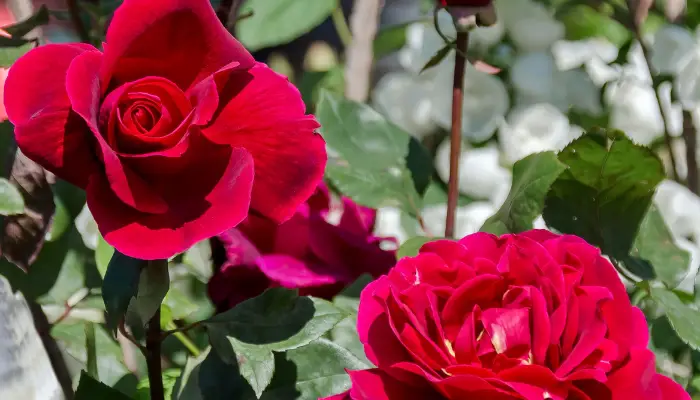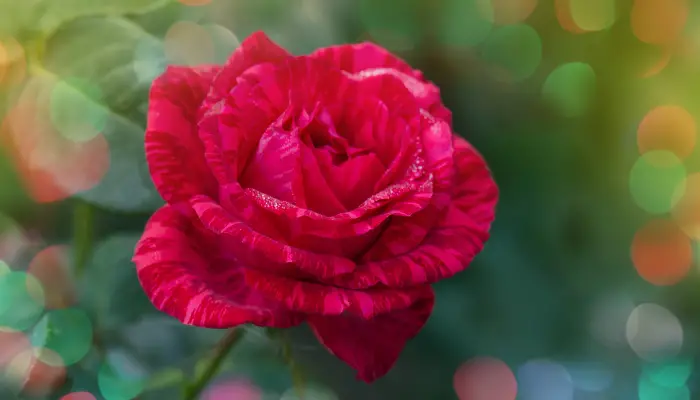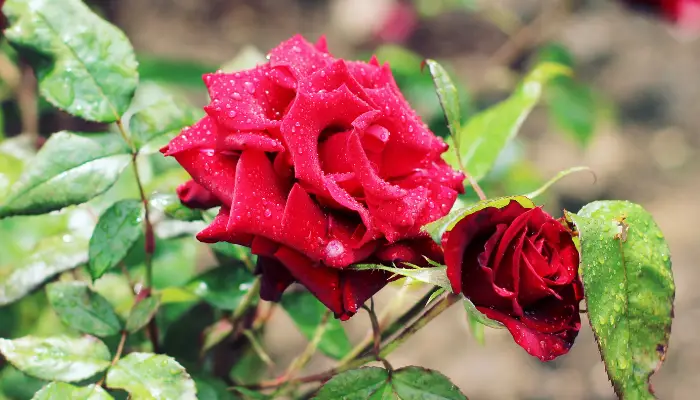Roses are one of the most popular and beautiful flowers in the world. They come in many varieties, colors, shapes, and sizes. But how long does it take for a rose to grow from a seed to a blooming flower?
The answer depends on several factors, such as the type of rose, the climate, the soil, the water, the sunlight, and the care. However, in general, it can take anywhere from six months to two years for a rose to grow from a seed to a flower.
The Stages of Rose Growth

How Long Does It Take for a Rose to Grow
A rose goes through four main stages of growth: germination, seedling, vegetative, and flowering.
Germination
Germination is the process of a seed sprouting and developing a root and a shoot. This stage can take from two weeks to two months, depending on the temperature, moisture, and dormancy of the seed. Some rose seeds need to be stratified, which means exposing them to cold and moist conditions for a period of time, to break their dormancy and stimulate germination.
Seedling
Seedling is the stage when the rose plant develops its first true leaves and stems. This stage can take from one to six months, depending on the growth rate and the environmental conditions. The seedling needs regular watering, fertilizing, and pruning to encourage healthy growth and prevent diseases and pests.
Vegetative
Vegetative is the stage when the rose plant grows larger and stronger, developing more branches, leaves, and buds. This stage can take from six months to a year, depending on the type and size of the rose. The vegetative stage is important for preparing the rose for flowering, as it determines the number and quality of the blooms. The rose needs adequate sunlight, water, nutrients, and pruning to promote vigorous growth and bud formation.
Flowering
Flowering is the stage when the rose plant produces its beautiful and fragrant flowers. This stage can take from a few weeks to a few months, depending on the variety and season of the rose. The flowering stage is the most rewarding and enjoyable part of growing roses, as it showcases the beauty and diversity of the rose. The rose needs regular deadheading, which means removing the faded or spent flowers, to prolong the blooming period and encourage new flowers.
The Factors That Affect Rose Growth
As mentioned earlier, the time it takes for a rose to grow from a seed to a flower depends on several factors, such as:
The type of rose
There are thousands of rose varieties, each with different characteristics and requirements. Some roses are faster and easier to grow than others. For example, miniature roses and polyantha roses are known to be quick and prolific bloomers, while hybrid tea roses and climbing roses are more slow and demanding.
The climate
The climate affects the temperature, humidity, and precipitation that the rose receives. Some roses are more tolerant and adaptable to different climates than others. For example, rugosa roses and shrub roses are hardy and resilient to cold and drought, while floribunda roses and grandiflora roses are more sensitive and susceptible to frost and heat.
The soil
The soil affects the drainage, aeration, and fertility that the rose receives. Some roses are more particular and selective about the soil than others. For example, damask roses and moss roses prefer rich and loamy soil, while alba roses and centifolia roses can tolerate poor and sandy soil.
The water
The water affects the hydration and nutrition that the rose receives. Some roses are more thirsty and hungry than others. For example, bourbon roses and noisette roses need frequent and generous watering and feeding, while gallica roses and china roses can survive with minimal and moderate watering and feeding.
- The sunlight. The sunlight affects the photosynthesis and flowering that the rose receives. Some roses are more sun-loving and shade-hating than others. For example, hybrid perpetual roses and hybrid musk roses need full and direct sunlight to produce abundant and colorful flowers, while old garden roses and species roses can bloom with partial and indirect sunlight.
- The care. The care affects the maintenance and protection that the rose receives. Some roses are more needy and delicate than others. For example, modern roses and English roses need regular and careful pruning, spraying, and mulching, while wild roses and antique roses can thrive with little and occasional pruning, spraying, and mulching.
The Tips for Growing Roses Faster and Better

Growing roses from seeds can be a challenging and rewarding hobby. However, it can also be frustrating and disappointing if the roses do not grow as fast and as well as expected. Here are some tips to help you grow roses faster and better:
- Choose the right type of rose for your purpose, preference, and condition. Do some research and find out which rose varieties are suitable and appealing for your garden, climate, soil, and taste.
- Start with healthy and viable seeds. Buy or collect high-quality and fresh seeds from reputable sources or reliable plants. Avoid old, damaged, or diseased seeds that may not germinate or grow well.
- Prepare the seeds properly. Soak the seeds in water for 24 hours to soften the seed coat and activate the embryo. Then, stratify the seeds in a moist and cold medium, such as a paper towel, a peat moss, or a plastic bag, for six to eight weeks to break the dormancy and stimulate the germination.
- Sow the seeds correctly. Plant the seeds in a sterile and well-drained potting mix, about a quarter inch deep and one inch apart. Cover the seeds lightly with soil and water them gently. Then, place the seeds in a warm and bright location, such as a windowsill, a greenhouse, or a grow light, and keep the soil moist but not soggy.
- Transplant the seedlings carefully. When the seedlings have two or three true leaves, transplant them to individual pots or containers with a larger and richer potting mix. Handle the seedlings gently and avoid damaging the roots. Then, place the seedlings in a sunny and sheltered location, such as a patio, a balcony, or a garden, and water them regularly.
- Feed the plants frequently. Fertilize the plants with a balanced and organic fertilizer, such as a compost, a manure, or a fish emulsion, every two to four weeks during the growing season. Follow the instructions on the label and avoid overfeeding or underfeeding the plants.
- Prune the plants properly. Prune the plants with a sharp and clean pruner, removing any dead, diseased, or damaged branches, leaves, or buds. Also, prune the plants to shape them, to improve the air circulation, and to encourage the flowering. Prune the plants in early spring, after the last frost, and in late summer, after the last bloom.
- Protect the plants from pests and diseases. Inspect the plants regularly and look for any signs of pests or diseases, such as aphids, mites, caterpillars, black spot, powdery mildew, or rust. If you find any, treat them promptly and effectively with a natural or chemical remedy, such as a soap spray, a neem oil, or a fungicide. Follow the instructions on the label and avoid overusing or misusing the remedy.
- Enjoy the flowers. When the flowers appear, admire them, smell them, photograph them, or cut them. However, do not forget to deadhead them, which means removing the faded or spent flowers, to prolong the blooming period and encourage new flowers.
Frequently Asked Questions
Q1: How long does it take for a rose to grow from seed to bloom?
A: The timeline can vary, but generally, it takes a few weeks for germination, followed by several months of growth to reach the blooming stage. The specific duration depends on factors like the rose variety, environmental conditions, and care provided.
Q2: What are the key factors influencing rose growth?
A: Climate, soil quality, watering, feeding, and proper pruning all play significant roles. A balanced approach to these factors contributes to healthy and timely rose development.
Q3: Can I grow roses in different climates?
A: Yes, roses are versatile and can be grown in various climates. However, different varieties may thrive in different conditions. Consult local gardening experts or nurseries for guidance on the best rose varieties for your specific climate.
Q4: How often should I water my roses?
A: Regular watering is crucial, especially during dry periods. Water deeply and consistently, ensuring the soil remains moist but well-drained. Adjust the frequency based on climate and soil conditions.
Q5: When is the best time to prune roses?
A: Pruning is typically done in late winter or early spring before new growth begins. Remove dead or weak wood, shape the plant, and encourage healthy growth. Avoid heavy pruning during the growing season.
Q6: What type of soil is best for roses?
A: Roses prefer well-draining, nutrient-rich soil with a slightly acidic to neutral pH. Amend the soil with organic matter like compost for optimal results.
Q7: Can I grow roses in containers?
A: Yes, many rose varieties can be grown in containers. Ensure the container has good drainage, use high-quality potting mix, and provide proper care, including adequate watering and feeding.
Q8: How do I protect my roses from pests and diseases?
A: Regular inspection, proper spacing, and maintaining good garden hygiene can help prevent common issues. Consider using organic pesticides or seeking advice from local gardening experts if problems arise.
Q9: Do all roses have a fragrance?
A: No, not all roses have a strong fragrance. Fragrance varies among different varieties, and some are bred specifically for their scent, while others focus on color or form.
Q10: Can I grow roses indoors?
A: While it’s challenging, some smaller rose varieties can be grown indoors. Provide ample sunlight, good air circulation, and monitor humidity levels. Be mindful of the potting mix and container size for proper growth.




